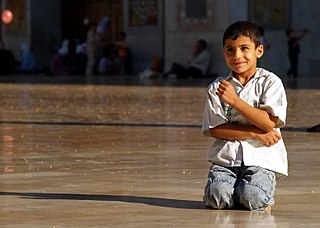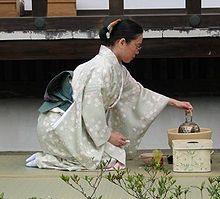
Sitting is a basic action and resting position in which the body weight is supported primarily by the bony ischial tuberosities with the buttocks in contact with the ground or a horizontal surface such as a chair seat, instead of by the lower limbs as in standing, squatting or kneeling. When sitting, the torso is more or less upright, although sometimes it can lean against other objects for a more relaxed posture.

The Aikikai is the original school of Aikido. It is centered on the Aikikai Foundation in Japan, and its figurehead is the Doshu. It is represented globally through the International Aikido Federation.

A zafu or putuan is a round cushion. Although also a utilitarian accessory, it is best known for its use in zazen Zen meditation.
Iwama-style Aikido(岩間合気道) is the style of aikido that was taught in Iwama by the founder of aikido, Morihei Ueshiba, and especially the lineage passed on through Morihiro Saito, a close disciple who was given responsibility over Iwama dojo by Ueshiba.

A kotatsu is a low, wooden table frame covered by a futon, or heavy blanket, upon which a table top sits. Underneath is a heat source, formerly a charcoal brazier but now electric, often built into the table itself. Kotatsu are used almost exclusively in Japan, although similar devices for the same purpose of heating are used elsewhere, e.g. the Spanish brasero or Iranian korsi.

Kneeling is a basic human position where one or both knees touch the ground. According to Merriam-Webster, kneeling is defined as "to position the body so that one or both knees rest on the floor". Kneeling with only one knee, and not both, is called genuflection.

A zabuton is a cushion for sitting that is commonly used in traditional Japanese settings. Zabuton is a Japanese loanword that is also sometimes used in Western culture to describe the zaniku, a flat mat that a zafu is placed on.

The horse stance is a common posture in Asian martial arts. It is called mǎbù (馬步) in Chinese, kiba-dachi (騎馬立ち) in Japanese, and juchum seogi or annun seogi in Korean. This stance can not only be integrated into fighting but also during exercises and forms. It is most commonly used for practicing punches or to strengthen the legs and back. The modified form of horse stance, in which heels are raised, is a fighting stance in International Karate Tournaments. The Chinese form of horse stance is a fighting stance which changes into front stance while using hip rotation to develop punching force.

A washitsu (和室), meaning "Japanese-style room(s)", and frequently called a "tatami room" in English, is a Japanese room with traditional tatami flooring. Washitsu also usually have sliding doors, rather than hinged doors between rooms. They may have shōji and, if the particular room is meant to serve as a reception room for guests, it may have a tokonoma.

A zaisu is a Japanese chair with a back and no legs. They are often found in traditional rooms with tatami mats, and are often used for relaxing under heated kotatsu tables.

Chūdan-no-kamae (中段の構え:ちゅうだんのかまえ), sometimes shortened to Chūdan-gamae or simply Chūdan, is a basic weapon stance in many Japanese martial arts. The name translates literally to "middle-level stance," as the sword is held before the user at chest height. Chūdan-no-kamae is also called Seigan-no-kamae (正眼之構), or "right/correct eye posture," because the stance points the tip of the sword at the opponent's eyes. In most traditional schools of swordsmanship, and in the practice of kendo, chūdan-no-kamae is the most basic posture, as it provides a balance between attacking and defensive techniques.

Agura is the Japanese term for the position normally referred to as sitting cross-legged in English.

Vajrasana, Thunderbolt Pose, or Diamond Pose, is a kneeling asana in hatha yoga and modern yoga as exercise. Ancient texts describe a variety of poses under this name.

Humans mostly use one of two types of defecation postures to defecate: squatting and sitting. People use the squatting postures when using squat toilets or when defecating in the open in the absence of toilets. The sitting posture on the other hand is used in toilets that have a pedestal or "throne", where users generally lean forward or sit at 90 degrees to a toilet seat.

Squatting is a versatile posture where the weight of the body is on the feet but the knees and hips are bent. In contrast, sitting involves supporting the weight of the body on the ischial tuberosities of the pelvis, with the lower buttocks in contact with the ground or a horizontal object. The angle between the legs when squatting can vary from zero to widely splayed out, flexibility permitting. Another variable may be the degree of forward tilt of the upper body from the hips. Squatting may be either full or partial.

Meditative postures or meditation seats are the body positions or asanas, usually sitting but also sometimes standing or reclining, used to facilitate meditation. Best known in the Buddhist and Hindu traditions are the lotus and kneeling positions; other options include sitting on a chair, with the spine upright.

Sitting or kneeling is an integral part of salah, or Islamic prayer, along with bowing.
Suwariwaza (座り技) is the generic name for techniques performed in the seated stance in traditional Japanese (koryū) martial arts. The word waza means technique. In aikido and judo, suwariwaza techniques are performed by practitioners seated opposite to each other in the seiza position, the formal style of sitting in Japanese culture. In iaido, a single practitioner starts in many cases from suwariwaza, and executes sword techniques from the seated stance, though not necessarily from a static and immobile position.

Bowing in Japan is the act of lowering one's head or the upper part of the torso, commonly used as a sign of salutation, reverence, apology or gratitude in social or religious situations.






















